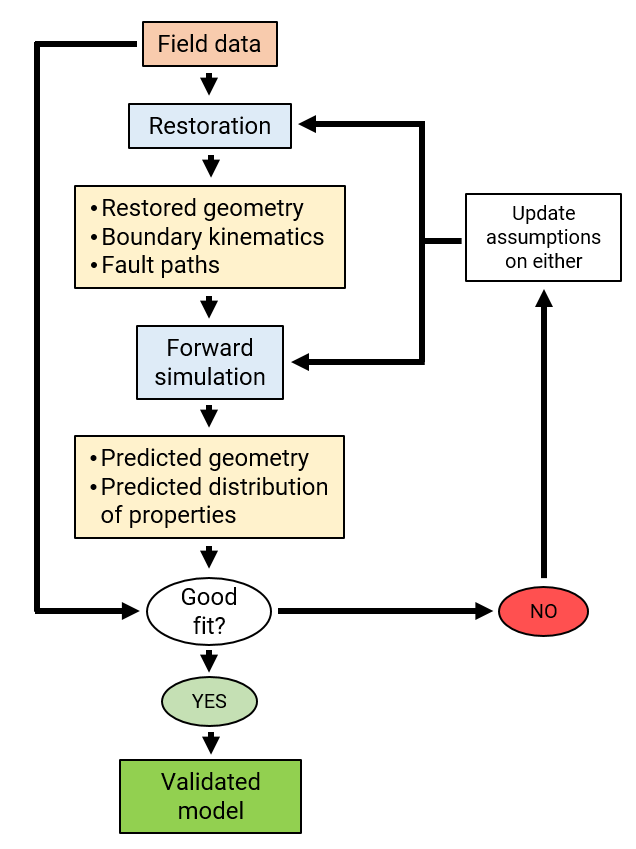Restoration to Forward simulation workflow
Sedimentary basins are complex natural systems, a few to several hundred million years old, that evolve from the early stages of basin formation to the present-day via a combination of natural processes such as sediment deposition, subsidence and burial, sediment compaction, diagenesis, sediment lithification, fluid over pressure development, fluid and heat flow, oil generation and migration, fault initiation and offset, deformation due to tectonic activity.
Forward geomechanical basin modelling allows numerical simulation of evolutionary basins by solving the governing equations and incorporating sophisticated constitutive models that capture the physics of the underlying the system. The main ingredients of the model are:
-
The initial paleo-geometry,
-
The constitutive relationships for all the sediments within the model domain and
-
The evolving boundary conditions
On the other hand, structural restoration is a technique to ‘un-deform’ a present-day geometry back to its original state or to a target paleo time. Structural restoration is applied to both validate structural interpretations made from seismic data and to infer past deformation states of geological structures, shedding light on the basin history and the kinematics involved in basin evolution. A structural restoration can, therefore, provide the initial paleo-geometry and evolving boundary conditions for geomechanical forward models.
ParaGeo has a robust framework that integrates restoration and forward modelling for both 2D and 3D structures with the objective of improving consistency, and therefore accuracy, of both the restoration and forward modelling procedures. This has the advantage that the forward model may be semi-automatically generated from the restoration results including:
-
Initial geometry
-
Boundary displacements
-
Depositional surfaces
-
Fault propagation pathways
This framework facilitates definition of the forward model while providing flexibility in the conditions being applied. For example restoration displacements may be used in the forward model to:
-
Prescribe displacements at the basal and side boundaries
-
Prescribe displacements at the whole basal formation and side boundaries
-
Prescribe displacements at the basal and side boundaries with specialized boundary conditions for faults (initially nodes at fault roots are prescribed and once a threshold distance is reached displacement constraints are released)
This framework integrates restoration and forward simulation for a wide range of scenarios including both extensional and compressional features. This is demonstrated in its application to a section from the Orange Basin which includes both extensional and compressional faults that root on a common detachment.

Geometries at the end of several restoration stages for a section from the Orange Basin

Detail of some boundary conditions adapted during the forward simulation for the Orange Basin section. Prescribed displacements and fault propagation paths are derived from restoration results.
Fault paths derived from restoration may be used to constrain fault propagation during the forward model. So each time a new formation is sedimented ParaGeo can:
-
Use restoration-derived fault paths to propagate some, or all, faults into the newly deposited formation following a discrete-fault approach by extending the fault contact surfaces
-
Use restoration-derived fault paths to propagate some or all faults in the model to the newly deposited formation following a continuum approach by decreasing the sediment strength along the fault paths
-
Allow un-constrained fault propagation where fault propagation is predicted using the constitutive response of the sediment to the evolving stress conditions
The integrated framework also enables an iterative improvement of either, or both, the restoration and forward simulations. The user can assess the fit between the predicted forward model results and the field data. Based on this assessment the assumptions on either the restoration or forward model may be updated in order to improve the prediction. For example, this approach may be used to improve both restoration and forward simulations by adding non-vertical decompaction in a restoration for a compressional setting. This will improve the restored bed-lengths (improve the under-estimation in recovered shortening) and consequently improve the predicted magnitude of compressional displacement in the forward simulation.

Comparison of the field observed geometry (target) and predicted geometry for the Orange Basin

The integrated restoration - forward modelling framework enables an iterative improvement of both restoration and forward simulation results
There is a dedicated workflow for performing restoration and forward simulation of 3D models at regional scale (100s of km) discretized via hexahedral meshes. For such workflow the procedure is as follows:
-
Geometry import from a 3rd party mesh (e.g. from Eclipse, Abaqus, GoCAD, Gmsh, etc). We have functionality to process the original data during conversion to ParaGeo format (e.g. pinchout and delete thin elements, subdivide elements, selective formation split for thick layers, etc). Note that the geometry may consider non-flat ragged boundaries.
-
Automatically identify and generate a list of the boundary nodes.
-
Simulation of 3D restoration. Displacement on boundary nodes at every restoration event are tracked and output into separate files.
-
Simulation of 3D forward model. Displacement from restoration is used as a boundary condition for the forward model in a reverse manner.

Sequence showing restoration and forward simulation of a regional scale model with a hexahedral mesh included in the tutorials from ParaGeo user's manual. V.E. = 5. The white spheres in the forward simulation indicate the nodes identified as external boundary to which boundary displacements from restoration are applied.
